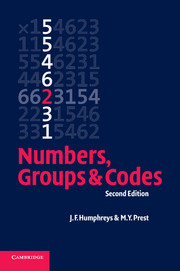Book contents
- Frontmatter
- Contents
- Preface to first edition
- Preface to second edition
- Introduction
- Advice to the reader
- 1 Number theory
- 2 Sets, functions and relations
- 3 Logic and mathematical argument
- 4 Examples of groups
- 5 Group theory and error-correcting codes
- 6 Polynomials
- Appendix on complex numbers
- Answers
- References and further reading
- Biography
- Name index
- Subject index
3 - Logic and mathematical argument
Published online by Cambridge University Press: 05 September 2012
- Frontmatter
- Contents
- Preface to first edition
- Preface to second edition
- Introduction
- Advice to the reader
- 1 Number theory
- 2 Sets, functions and relations
- 3 Logic and mathematical argument
- 4 Examples of groups
- 5 Group theory and error-correcting codes
- 6 Polynomials
- Appendix on complex numbers
- Answers
- References and further reading
- Biography
- Name index
- Subject index
Summary
Mathematics and mathematical reasoning is precise. This is in contrast to most discourse where deductions and chains of reasoning have gaps and imprecision. A chain of reasoning in mathematics should be compelling, in the sense that anyone who can follow the argument (which might, of course, be a very difficult task), should feel obliged to accept its correctness. Of course, in practice mathematical arguments can contain errors. But again, once an error has been pointed out, it should not be a matter of opinion whether or not there is an error. Over the centuries, indeed millennia, people have puzzled over what makes a chain of reasoning watertight. Especially over the past 150 years the logic of mathematics has been thoroughly investigated. A rather remarkable outcome of this mathematical investigation of logic is that it is, in principle, possible to formalise mathematical reasoning to the point where any purported mathematical argument could be checked by a computer. By this, we mean that the chain of reasoning can be checked (the correctness or applicability of the conclusions rather depends on the assumptions made at the outset).
It is interesting that, in practice, mathematicians do not always or even often produce proofs that are in a form which are easily computer checkable. Simple lemmas and computations are susceptible to such formal checking but, typically, proofs are quite (or very) complex and are written in a way which makes them comprehensible to human readers who have the necessary factual background and who have developed sufficient intuitive understanding that they do not need all the details to be written down.
- Type
- Chapter
- Information
- Numbers, Groups and Codes , pp. 127 - 146Publisher: Cambridge University PressPrint publication year: 2004



